Best
Beginner Guitar
-
Overall: Perfect for aspiring guitarists
-
Best Feature: Great resonance and projection with dreadnought shape
-
TedScore™: 9/10
Best
Intermediate Guitar
-
Overall: Excellent resonance suited for different musical genres
-
Best Feature: Incredibly comfortable C-shaped neck and smooth walnut fingerboard
-
TedScore™: 8/10
Best
Electro acoustic
-
Overall: Glorious natural tones from spruce & ziricote fine veneer body
-
Best Feature: Electronic capabilities enabled by Fishman MX-T
-
TedScore™: 8/10
Whether you’re a beginner, a keen amateur or a seasoned pro, buying a new acoustic guitar is always exciting.
This acoustic guitar buyer’s guide will help you figure out which guitar you should buy and why it will be such a good fit for you.
Before we talk about acoustic guitar brands, though, we need to address an important question.
why play an acoustic?
When it comes to playing guitar, there are a lot of different options out there. You can go electric, or you can stick with the classic acoustic sound. Acoustic guitars have a lot of advantages that make them a great choice for beginners – and our dedicated article, ‘Best Acoustic Guitars For Beginers’ might be helpful.
Don’t worry however, in our acoustic guitar buying guide, we’ll give you everything you need to know to make the right choice for you!
For one thing, they’re relatively affordable, so you don’t have to spend a lot of money to get started. They’re also generally smaller and lighter than electric guitars, making them more comfortable to hold and play.
And since they don’t need to be plugged in, you can practice anywhere without having to worry about finding an outlet. Most acoustic guitars are also generally very versatile, so you can play a wide range of styles on them.
Whether you’re looking to play folk, country, or pop music, an acoustic guitar is a great choice. So if you’re thinking about picking up a guitar, consider going acoustic. You won’t be sorry you did.
Is an acoustic guitar what you really want?
With all that said, how do you know if playing the acoustic guitar is really the right thing for you?
Here are some handy bits of information to help you find the your best acoustic guitar out there and then decide which one you should buy:
Should I Go Acoustic Or Acoustic-Electric?
This can be a tricky issue to tackle, especially for beginners and new guitarists.
To the untrained eye, acoustic guitars and electro-acoustic guitars are the same things. However, dig beneath the surface, and you’ll find a whole world of differences.
So before we can know which you should buy, let’s first see how they are different.
Acoustic Vs Electro-Acoustic
Acoustic guitars have a large, hollow body which is sometimes referred to as a “sound box”. This is a vitally important part of the guitar because it allows the guitar to project its sound.
Electro-acoustic guitars still have a sound box, but the crucial difference is that they also have a pickup and preamp hidden away in the body of the guitar. Just in case it’s useful, we have a great list of acoustic and electro-acoustic guitars in our ‘Best Acoustic Guitar Under 1000‘ article.

So yes, they can still resonate and be played like an acoustic guitar, but what are the advantages of having the pickup and preamp?
The extra gear that’s hidden away in the electro-acoustic means that it can be plugged into an amplifier.
This will be really handy if you’re playing live, and it’s much easier (and less expensive) to record them.
You don’t need expensive microphones. You just need a cable to plug it into a mixing desk or audio interface.
You’ll also find that many electro-acoustic guitars come with a set of EQ and tone controls.
These are very similar to those that you’d find on a regular electric guitar.
You’ll have a volume control, tone control, and sometimes bass, treble, and midrange boost and cut.
The borrowing from the electric guitar doesn’t stop there either.
Many electro-acoustic guitars also have a small cutaway in the body to make the higher or upper frets more accessible to playing guitar.
You may have read that and wondered if that makes the guitar less resonant.
You’re right it does. But this doesn’t matter because, just like the electric guitar, the electro-acoustic guitar can use an amplifier to project its sound, so if the resonance and sound box are compromised, it’s not a big issue.
Other Differences In Electro-Acoustic Guitars
The added pickup and preamp in the electro-acoustic guitar will make the guitar what’s known as “active”.
The term active simply means that a small nine-volt battery must be placed into the guitar to power the pickup and preamp.
These batteries usually last months, so they won’t become a big expense.
When played onstage, electro-acoustic guitars can often feedback too.

Feedback occurs when the guitar sound coming out of an amplifier is picked up again by the guitar’s own pickups, and a feedback loop is created.
A feedback blocker is a great way to stop this. Many electro-acoustics will have smaller bodies that are partly made from hardened plastic.
This can be great for beginner guitarists because it’s easier to play, and the plastic is also very durable.
So if your child is a little careless about the new guitar you bought them, then you won’t have to worry as much.
What is the difference between a classical guitar and an acoustic guitar?
Acoustic guitars and classical guitars are both string instruments that can trace their origins back to the 16th century. However, there are several key differences between these two types of guitars.
Perhaps the most obvious difference is their size; acoustic guitars are usually larger than classical guitars, with longer necks and wider bodies. This makes them more difficult to play in some positions, but also allows them to produce a louder sound.
Acoustic guitars also have steel strings, which produce a brighter, richer tone than the nylon strings used on classical guitars.

Finally, acoustic guitars are often played with a pick, while classical guitars are always played with the fingers. These different playing styles produce different sounds, and give each type of guitar its own unique character.
What to look for in an acoustic guitar
There are three primary factors that you should look for when purchasing an acoustic guitar: comfort, sound, and personal preference. First, it is important to find an acoustic guitar that is comfortable for you to play.
This means that the weight and size of the guitar should be appropriate for your body type, and that the strings should not be too far from the fretboard.
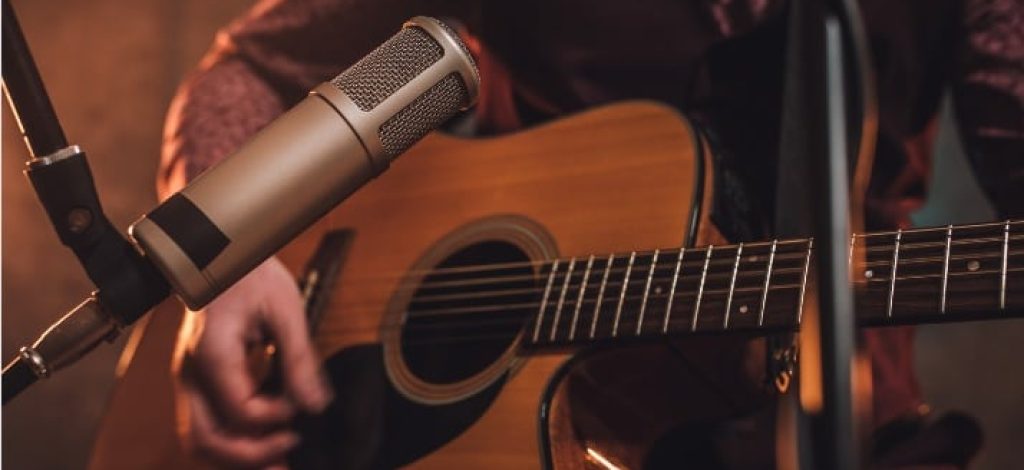
Second, you should make sure that the acoustic guitar has a good sound. This can be difficult to judge if you are a beginner, but it is still important to listen for a balanced tone and clear notes.
Finally, you should choose an acoustic guitar that you personally like. This may mean choosing a guitar with a certain finish or style, or it could simply come down to choosing the one that feels right for you.
Ultimately, the best way to find the perfect acoustic guitar is to try out as many as possible until you find the one and best guitar that is just right for you.
Top tips when buying an acoustic guitar
Look for something that is easy to play. Yes, there are always some slight pains when getting used to a new instrument but those disappear very quickly.
If the instrument doesn’t feel comfortable and easy for you to play straight away then it’s not right for you.
Get something that you feel has a good sound because you will need to enjoy playing it and that won’t happen if you hate the sound.

And, finally, stick to your budget!
It’s very easy to go overboard but there’s really no point. There’s no shame in having a budget, no matter what size it is.
How much does an acoustic guitar cost?
Next up for this acoustic guitar buying guide is the inevitable conversation of price.
This is no bad thing, and you should never feel (or be made to feel) bad about worrying about your bank balance.
Sometimes shop assistants can get a little pushy. Especially if they get a commission on the gear, they sell (another great reason to shop online) so just know that there’s never anything wrong with having a budget and sticking to it. If you’re on a tight budget, then take a look at our ‘18 Best Acoustic Guitars under 500‘.
So, why do some guitars cost more?
Brand Names
As with any other industry in the world, the best brands can charge more.
The list price of a Taylor (a very established brand) will be more than the list price of a beginner model you find online.
This isn’t Taylor being greedy. They are a fantastic brand, and they are worth every penny, but part of their worth comes from the fact that they are a brand many acoustic guitar players want to play.
Think of it as being similar to owning a Mercedes, Bentley or Tesla!

Whilst they are great cars in their own right, part of the thrill of owning one comes from the fact that you own something that’s exclusive and high in quality, so you’ll want to show it off.
That showing-off feeling is an inherent part of its value to you as a consumer
Build Quality
The best acoustic guitars are made from the best materials and by the best guitar craftsmen.
As with anything else in life, the more experienced luthier you want involved, the more you’ll have to pay for their time.
And why is their time so valuable? Well, put it this way.
Because they’re so good at what they do, if you don’t pay their going rate, then the next person in line will.
They have the luxury of choice.

But that doesn’t mean all luthiers are money hungry. They’re wonderful people who have dedicated their whole lives to creating incredible instruments.
They will also have great connections to suppliers of great woods to use in the guitars construction.
The best acoustic guitars are often made from the best woods, and you’ll really notice a difference in the quality of the sound and how the guitar feels to play.
As a general rule of thumb, remember that the better the build quality, the higher the price will likely be.
Playing Style
Now, this will seem like a strange issue to include as a price factor.
Why does wanting to be a fingerstyle player mean you’ll have to pay a different price from a nylon string guitars player who wants a classical acoustic guitar?
Part of that is just supply and demand in the marketplace.
Acoustic and electro-acoustic guitars are far more popular with beginners and new guitarists than classical guitars are, so companies are able to charge more for their guitars.
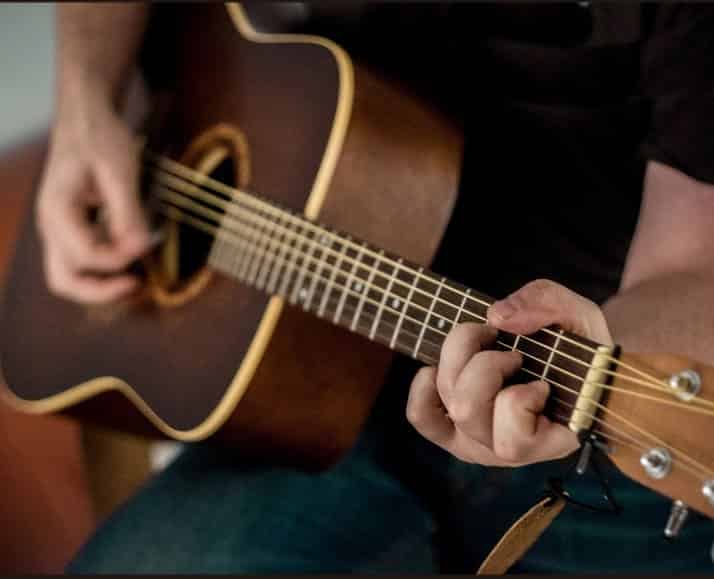
But playing style also goes deeper into this discussion.
Some acoustic and acoustic-electric guitars are purposefully designed for people who want to play fast, who want to play chord-melody style or who want something that’s physically smaller but still really resonant.
And since these are all much more bespoke options, they will come with a more bespoke price tag.
Acoustic guitar anatomy
The body of the acoustic guitar is where the sound is produced. The soundhole helps to project the sound and is usually surrounded by intricate rosette designs. The top of the body is called the soundboard and is typically made from spruce.
The back and sides are usually made from mahogany, which gives the guitar its characteristic warm tone. The guitar neck is attached to the body and is where the strings are stretched.
The fretboard runs along the guitar neck and contains metal frets that help the player produce different notes. The headstock is located at the end of the neck and contains tuning pegs that can be adjusted to tighten or loosen the strings.
The bridge holds the strings in place and transmits their vibrations to the soundboard. These parts work together to produce the beautiful sound of an acoustic guitar.
Acoustic guitar body woods
Acoustic guitars can be made from a variety of woods, each with its own unique appearance and sound. The most common type of wood used for acoustic guitars is spruce. Spruce is a light-colored wood that produces a bright, clear tone. It is also very stiff, which helps the guitar to produce a lot of volume.
Cedar is another popular choice for acoustic guitars. It is a bit softer than spruce, which gives it a warmer, richer sound. Cedar is also very lightweight, making it a good choice for smaller players. Mahogany is another popular option for acoustic guitars. It is a dark-colored wood that has a very warm, full sound.

Mahogany is also quite heavy, which gives the guitar a lot of body and depth. Finally, rosewood is often used for the back and sides of acoustic guitars. It is a very hard, dense wood that produces a clear, articulate tone.
Rosewood is also very beautiful, with a rich, dark color that deepens over time. Acoustic guitars made from these different woods will all have their own unique appearance and sound.
Acoustic guitar construction and design
Acoustic guitars have been around for centuries, and their popularity is only increasing. Though their design has undergone some changes over the years, the basic principles remain the same.
The acoustic guitar body styles are typically made from solid wood top, though some models may use laminated wood instead. The soundboard, or top, is responsible for amplifying the sound of the strings and is usually made from a softer wood like cedar or spruce body style.

The soundhole helps to project the sound outward and is usually round or oval in shape. The bridge holds the strings in place and transmits vibrations from the strings to the soundboard.
Finally, the fretboard is where the player presses down on the strings to create different notes. By understanding the basics of how an acoustic guitar is designed and constructed, you can appreciate this instrument even more.
Acoustic guitar electronics
Some acoustic guitars will have electronics inside for pickups or sometimes in-built tuners. The piezoelectric or piezo pickup converts the string vibrations into electrical signals. These are then passed through an amplifier to make the sound louder.
The in-built tuner is used to tune the guitar by picking up the vibrations of the strings and converting them into a signal that can be displayed on a screen.

Types of acoustic guitar
Now let’s turn our attention to the different types of acoustic guitar.
Three types of Acoustic guitar
Let’s start with flat top guitars. These are the most common type of acoustic guitars, and they’re typically what people think of when they think of an “acoustic guitar.”
They have a flat top and a round sound hole, and they’re usually played with a pick.
Archtop guitars are less common, but they’re still pretty popular. They have a curved top and a cutaway body, which gives them a different (and some would say, better) tone than flat-top guitars.
Finally, we have 12-string guitars. These are similar to flat-top guitars, but they have 12 strings instead of six. They’re usually played with a pick as well, but some people prefer to use their fingers.
Flat-top guitars, archtop guitars & 12-string guitars

Now let’s talk about the differences between these three types of acoustic guitar.
The most obvious difference is the shape of the body. Flat-top guitars have a flat top and a round sound hole, while archtop guitars have a curved top and a cutaway body. 12-string guitars are similar to flat-tops, but they have twice as many strings.
This gives them a richer, fuller sound than either of the other two types of guitar. Another difference between these types of guitar is the
How to choose a guitar that’s right for you
So you want to buy an acoustic guitar. Here are a few things to keep in mind when choosing which one is right for you.
First, it’s important to try out a lot of different guitars in person. Get a feel for which ones are comfortable to play and which ones sound good to you.
Second, don’t be afraid to purchase your guitar online.
You can often find better deals than you would in a brick-and-mortar store. And finally, trust your gut.
Go with the guitar that feels right and sounds good to you. With a little bit of research, you’re sure to find the perfect acoustic guitar for you.
Acoustic guitars for beginners
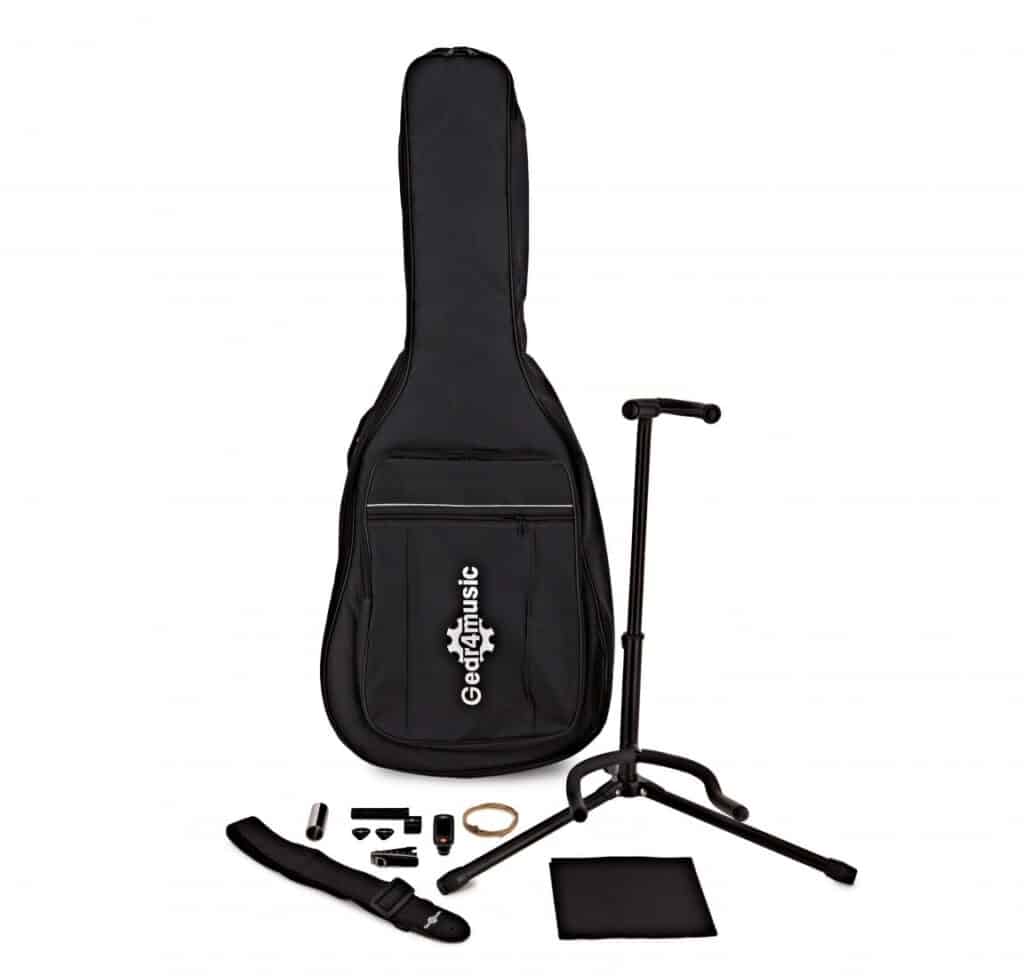
When beginners are looking to buy their first guitar, they should often look for a beginners guitar bundle. This is because they will get a good quality guitar and all the essential accessories at a very affordable price.
The guitar bundle will usually include a tuner, strings, a strap, and a case. This way, the beginner will have everything they need to get started playing the guitar. The guitar in the bundle will often be a acoustic guitar or an electric guitar.
The beginner should make sure to choose the right style of guitar for their needs. If the beginner is unsure of which type of guitar to choose, they should ask a salesperson for help.
By choosing a beginners guitar bundle, the beginner will be able to get everything they need to start playing the guitar without spending too much money.
Children’s guitars

If you’re a parent thinking about buying an acoustic guitar for your child, you should look into getting a purpose-made children’s guitar bundle.
Yes, you can find cheap guitars at garage sales or online, but they might not be good quality and they definitely won’t come with all the accessories your child needs to get started playing.
But with a children’s guitar bundle, you get a good quality guitar plus all the essential accessories – like a tuner, lesson book, and extra strings – for a very affordable price.
Plus, most bundles come with a padded gig bag to protect the guitar when your child is transporting it or taking it to guitar lessons.
So if you’re looking for a less expensive guitars way to get your child started on the road to becoming a musical prodigy, look into getting them a children’s guitar bundle.
What are the advantages of a smaller guitar?

Many people believe that it is better for small children to learn on smaller-scale acoustic guitars. Smaller-scale guitars are often lighter and easier to hold, which can make them more comfortable for young students.
Additionally, the strings on smaller-scale guitars are usually closer together, making it easier for small hands to form chords. While larger guitars may have a richer sound, they can be difficult for young students to hold and manage.
As a result, many guitar teachers recommend starting students on smaller-scale guitars. With proper care and practice, your child can develop the skills needed to play any type of guitar.
What guitar to choose according to age group

Acoustic guitars come in different sizes to suit different age groups. Smaller-scale acoustic guitars are designed for young children, 3/4 sized models are aimed at teenagers and then full-sized acoustic guitars are for ages 16 and over.
The body size of the guitar is important for two reasons. Firstly, it needs to be comfortable for the player to hold and play.
Secondly, the sound produced by the guitar will be different depending on its size. A small guitar will have a quieter sound, while a larger guitar will be louder.
So, when choosing an acoustic guitar, it is important to consider the size of the instrument as well as the age of the player.
Acoustic guitars for experienced players

Many professional and experienced acoustic guitar players often get custom-made instruments from luthiers, rather than buying mass-produced models. The reason for this is that these highly specialized instruments are the perfect tool for their specific needs and style of playing.
Luthiers are able to create an instrument that is tailored to the player’s individual requirements, resulting in an instrument that is perfectly suited to their playing style.
In addition, custom-made instruments often have a higher quality than mass-produced models, making them a better investment in the long run.
As a result, it is clear that luthiers play an important role in the music industry, providing musicians with the perfect tools for their craft.
Steel strings v nylon strings
Steel acoustic guitar strings are typically comprised of carbon steel wrapped in either bronze or nickel. They are most commonly used for folk, country music, and blues music. Nylon classical guitar strings are typically made of nylon (polyamide), which is a synthetic polymer.
They are most commonly used for classical and flamenco music. Both types of strings have their own unique tonal quality. Steel string acoustic guitars tend to produce a brighter, more aggressive sound while nylon string guitars produce a warmer, mellow tone.
Each type of string also has its own unique feel. Steel strings tend to be much stiffer and harder on the fingers than nylon strings. When choosing between the two, it is important to consider what style of music you will be playing and what kind of sound you are trying to achieve.
If you’re wanting to find out more about guitar strings, then look at our ‘Best Acoustic Guitar Strings‘ article.
How to choose guitar strings
The guitar’s strings are made from a variety of materials including metals like bronze, brass, and steel, as well as synthetic materials like nylon and fluorocarbon for most acoustic types.
Each type of string has its own unique tone and feel, so it’s important to choose the right ones for your instrument and your playing style. If you’re not sure where to start, your best bet is to try out a bunch of different types and brands until you find the ones you like the sound of best.

When it comes to feeling, personal preference is really the only guiding factor, so go with the strings that feel the nicest to play. With so many great options available, there’s no need to settle for anything less than perfect.
Accessories for the acoustic guitar
Now let’s take a close look at accessories for the acoustic guitar.
Cases
There are two options as far as guitar cases are concerned.
Your first option is to go for a soft case that will be easier to transport but offers less protection.
These are almost like guitar backpacks. They have straps that can be worn like backpacks and often have plenty of pockets and extra storage so you can comfortably transport your guitar around as well as your spare strings, tuners, sheet music and any other important accessories.
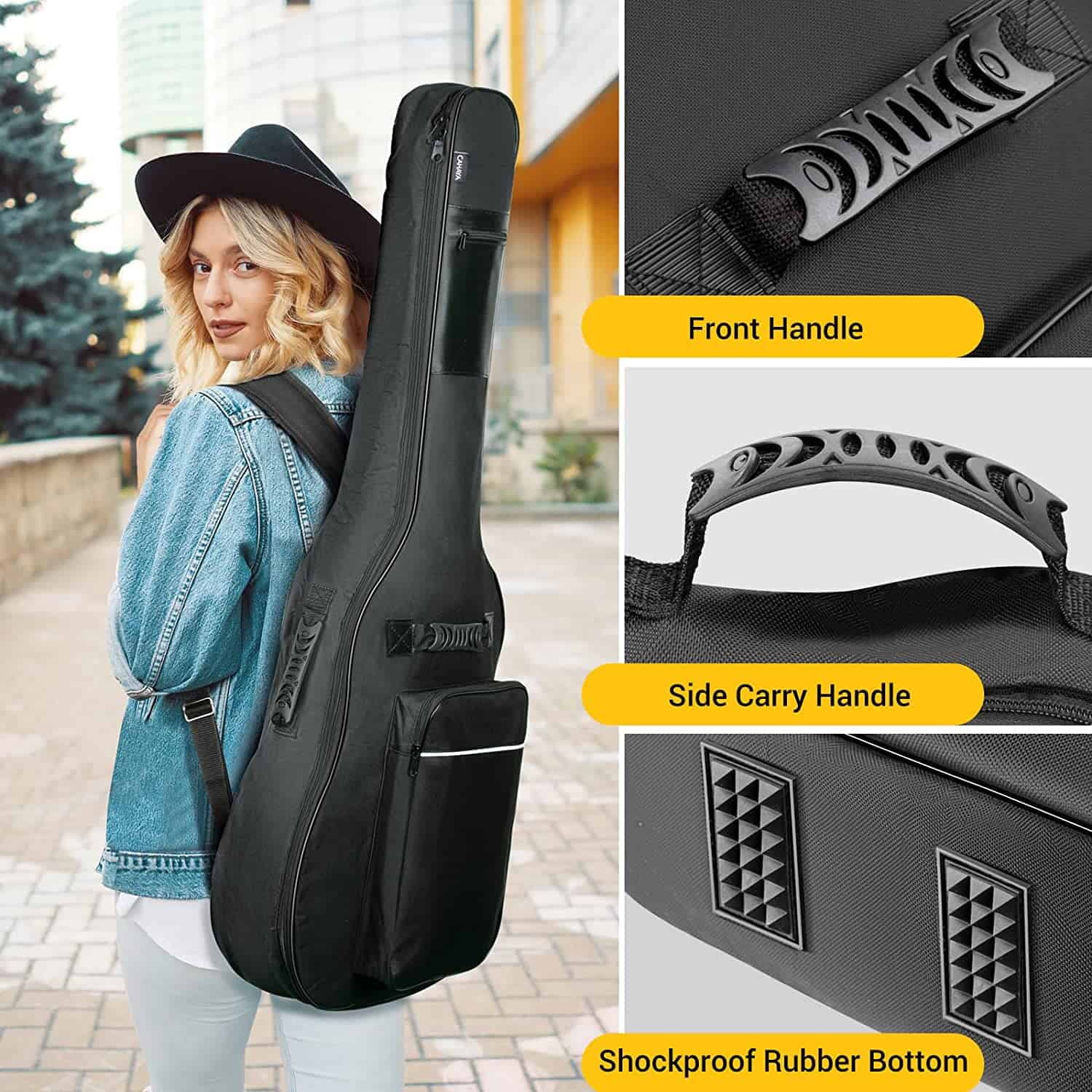
DESIGNED FOR: People who need to travel
COMES WITH: Side carry handle
FEATURES: Shockproof Rubber Bottom
CAHAYA CY0149 Guitar Bag Gig Bag
When you check the price above, you’ll see there are loads of great places to buy this item. Our personal favorite is Gear4music.
It is the largest music retailer in the UK and fast becoming the most respected online music shop in the US too. Their customer service is excellent, they have competitive prices, really fast shipping, and usually have the longest guarantee.
Most professional musicians use Gear4music, so there is no reason why you shouldn’t too!
- Water Resistant
- Large Storage Capacity
- Not as sturdy as a hard case
The professional musician who wrote this article combined many things,
from the product build, manufacturer’s reputation through to feedback
from other users, to create our famous TedScore™.
The second option is to go for a hard case that will help keep your instrument safe and protected from wear and tear but are far less convenient to carry around with you.
A hard case can’t be worn like a backpack, and often storage is compromised to gain greater protection.

DESIGNED FOR: Safe Transportation of Instruments
COMES WITH: Interior Storage Spaces
FEATURES: Lockable Latches
Dreadnought Acoustic Guitar Hard Case
When you check the price above, you’ll see there are loads of great places to buy this item. Our personal favorite is Gear4music.
It is the largest music retailer in the UK and fast becoming the most respected online music shop in the US too. Their customer service is excellent, they have competitive prices, really fast shipping, and usually have the longest guarantee.
Most professional musicians use Gear4music, so there is no reason why you shouldn’t too!
- Durability
- Provides Maximum Protection
- Heavier & Bulkier Than a Soft Case
The professional musician who wrote this article combined many things,
from the product build, manufacturer’s reputation through to feedback
from other users, to create our famous TedScore™.
Straps
Look for a strap that is wide and thick. This means it will help spread the weight of the guitar properly which thin and narrow straps can’t do.
Proper weight distribution of this kind will help minimize the chance of an injury.
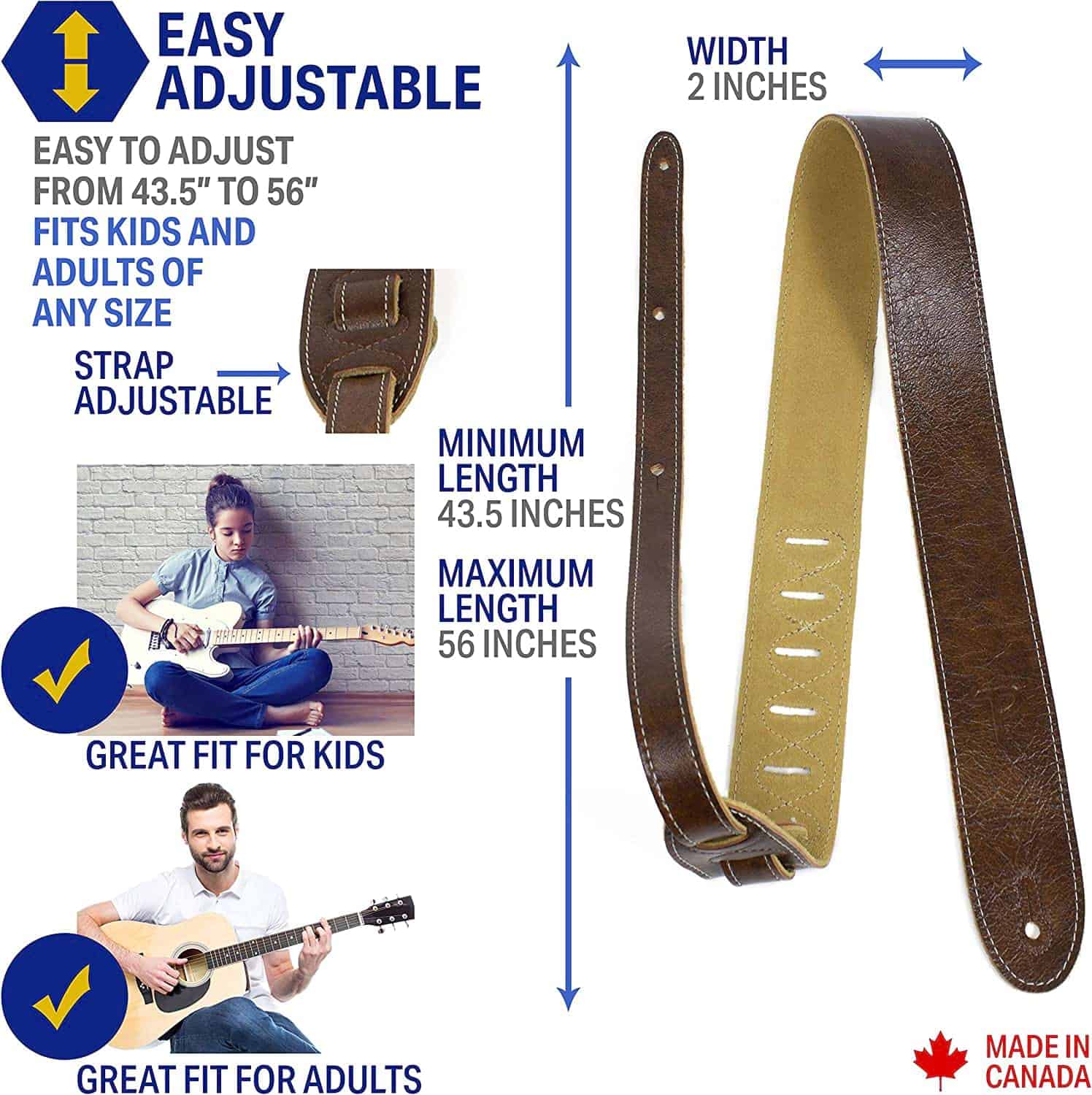
DESIGNED FOR: Kids & Adults
COMES WITH: Lifetime Warranty Guarantee
FEATURES: High-Quality Solid Leather
Perri’s Leathers Adjustable Guitar Strap
When you check the price above, you’ll see there are loads of great places to buy this item. Our personal favorite is Gear4music.
It is the largest music retailer in the UK and fast becoming the most respected online music shop in the US too. Their customer service is excellent, they have competitive prices, really fast shipping, and usually have the longest guarantee.
Most professional musicians use Gear4music, so there is no reason why you shouldn’t too!
- Beautiful Leather Exterior & Interior
- Non-Slip & Strong
- Adjustable Size
- None!
The professional musician who wrote this article combined many things,
from the product build, manufacturer’s reputation through to feedback
from other users, to create our famous TedScore™.
Amps
Acoustic guitar amps are not all that common because, by nature, an acoustic guitar doesn’t need one. However, acoustic-electric guitars can use amps.
The benefit to using an amp is that it can help an acoustic-electric guitar project its sound more effectively in a live setting. Acoustic guitars rely on their body to project sound, and while this is fine in smaller settings, it can be difficult to hear an acoustic guitar in a large room or outdoor setting.
This is where an amp comes in handy. It can amplify the sound of an acoustic-electric guitar so that it is easier for audiences to hear.

Additionally, amps can also be used to shape the sound of an acoustic-electric guitar, giving players more control over their tone. While acoustic guitars don’t require an amp, they can be a helpful tool for those who play them.
Tuner
This will make tuning quick and easy. This clip-on tuner is ideal for either acoustic or electric acoustic.
A tuner will make tuning keys quick and easy.
Often beginners haven’t yet developed the skills they need to tune by ear. Having an electronic device to tune for you is perfect for new players.

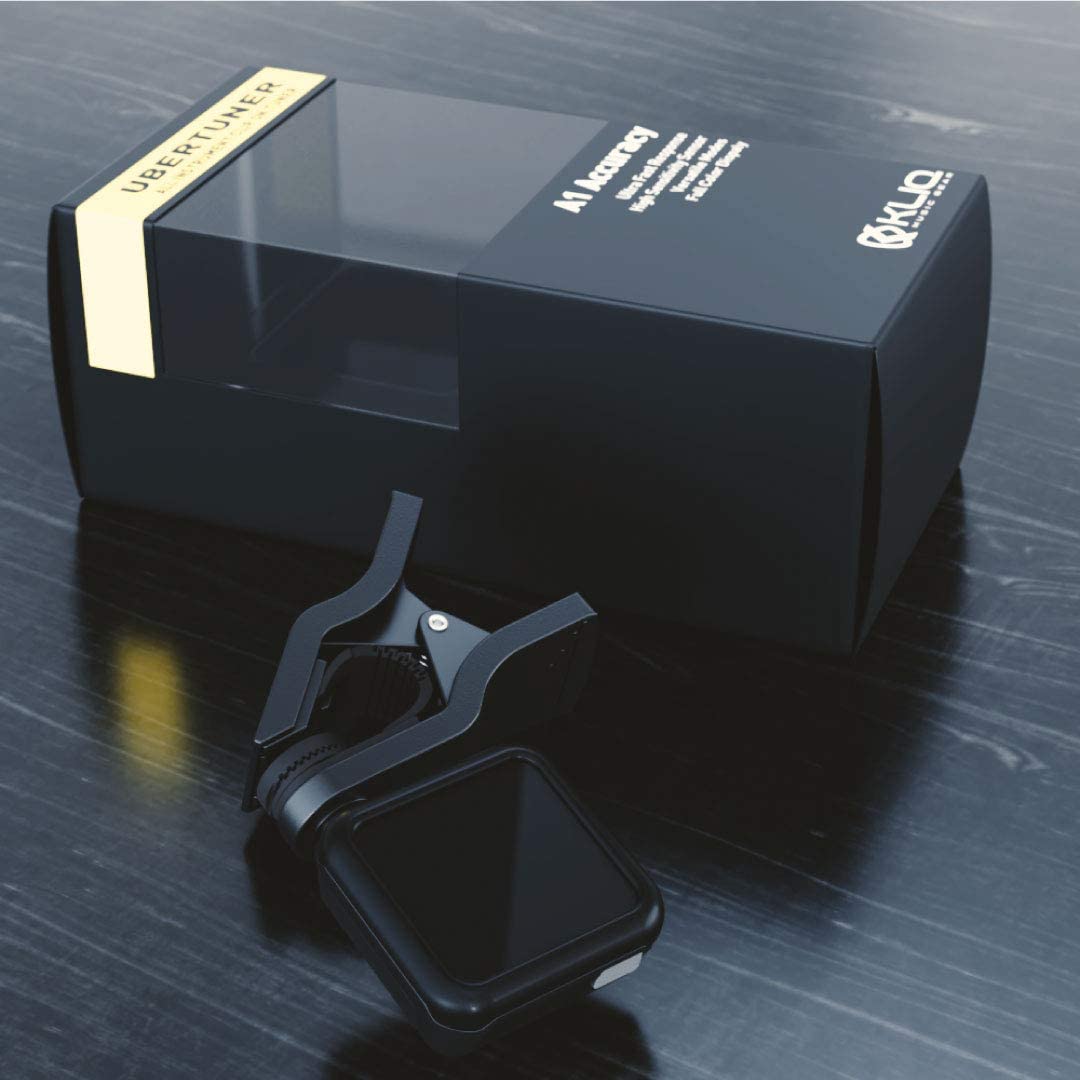
DESIGNED FOR: All guitar players
COMES WITH: Super Bright Display
FEATURES: Fast and Accurate
When you check the price above, you’ll see there are loads of great places to buy this item. Our personal favorite is Gear4music.
It is the largest music retailer in the UK and fast becoming the most respected online music shop in the US too. Their customer service is excellent, they have competitive prices, really fast shipping, and usually have the longest guarantee.
Most professional musicians use Gear4music, so there is no reason why you shouldn’t too!
- Ergonomic shape and easy to attach
- Small & Compact
- Stylish design
- None!
The professional musician who wrote this article combined many things,
from the product build, manufacturer’s reputation through to feedback
from other users, to create our famous TedScore™.
Music stand
You’ll need a place to put your sheet music when you play (and no, balanced across your knee is never a good idea).
A music stand is a must-have for any student.
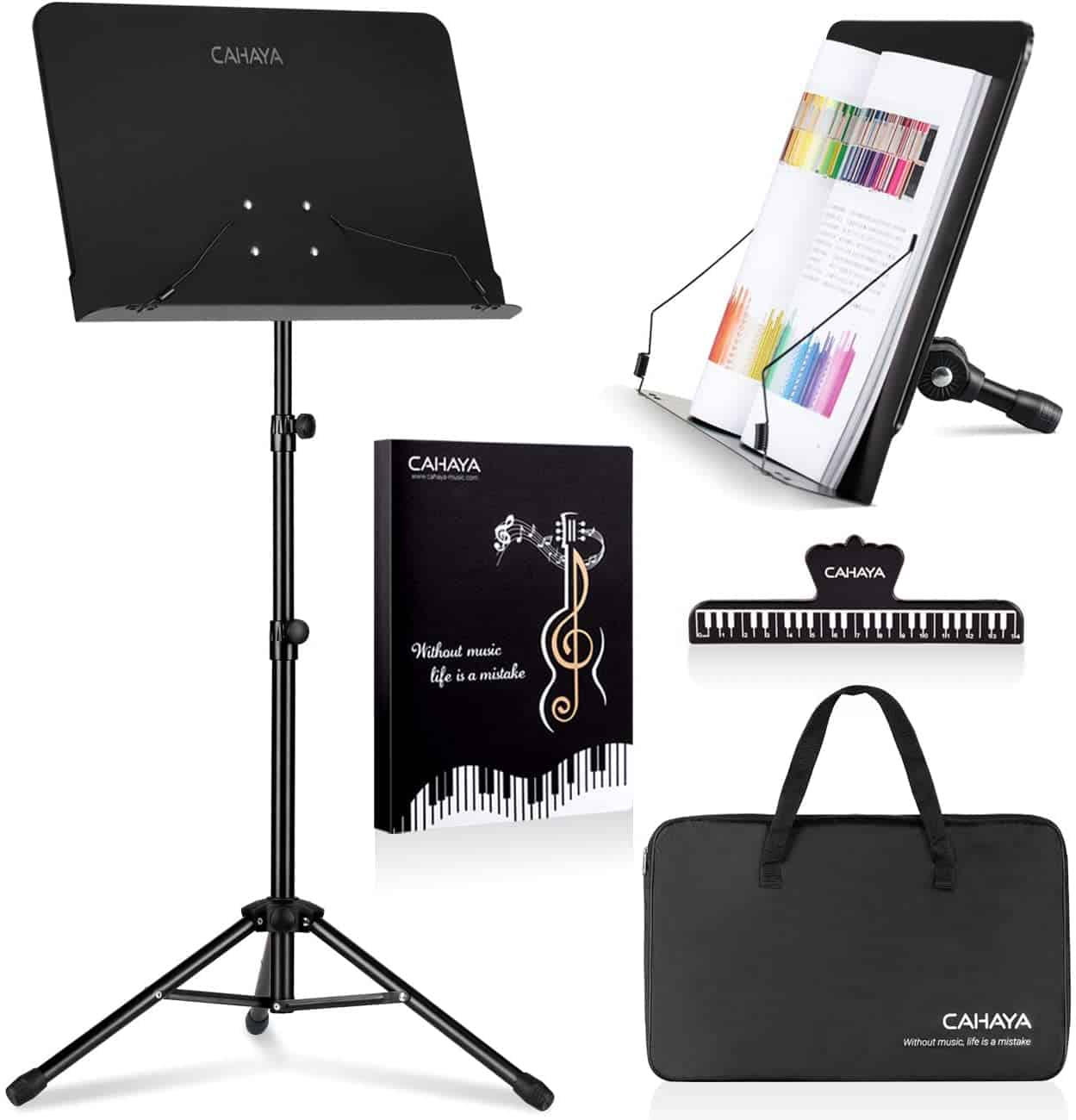
BEST FEATURE: Seriously well-made & sturdy
INCLUDES: Light | Carry Case | Sheet Music Clip
FEATURES: A carrying bag and a sheet music folder
When you check the price above, you’ll see there are loads of great places to buy this item. Our personal favorite is Gear4music.
It is the largest music retailer in the UK and fast becoming the most respected online music shop in the US too. Their customer service is excellent, they have competitive prices, really fast shipping, and usually have the longest guarantee.
Most professional musicians use Gear4music, so there is no reason why you shouldn’t too!
- Amazing complete kit
- Has everything you need
- Strong, yet transportable
- None!
The professional musician who wrote this article combined many things,
from the product build, manufacturer’s reputation through to feedback
from other users, to create our famous TedScore™.
Acoustic guitar buying guide
Summary
I’ve said plenty of times you should go with the guitar that will make you happy.
Yes, the wood is important.
So is the body shape, the type of strings, such as steel or nylon strings and the feel of the neck.
But the most important thing is that you like what you buy.
If you’re unsure, then ask yourself the following just before you’re about to add a new guitar to your online basket and press order; ‘will this guitar make me happy’? If the answer is yes, then go for it!
Happy strumming and good luck with your purchase!
FAQ's
It’s not superficial to worry about looks. If the guitar always makes you want to pick it up because it looks so good to you, then that’s important.
If it’s going to break the bank and really put you in a hard position, then it’s not worth it.
Have you read customer reviews?Have a lot of other buyers (who are probably just like you and buying for the same reasons as you) said that the guitar you want is great? If so, that probably means it’s a solid bet and would be a great investment.
If you can’t quite say why but for whatever reason, something just feels wrong, then it doesn’t matter if you don’t understand why. You have to live with the guitar you buy, and if it makes you feel bad, then don’t buy it.
If it does, and you can afford it, then buy and have a great time learning to play on an instrument that makes you feel like the best guitarist in the world!



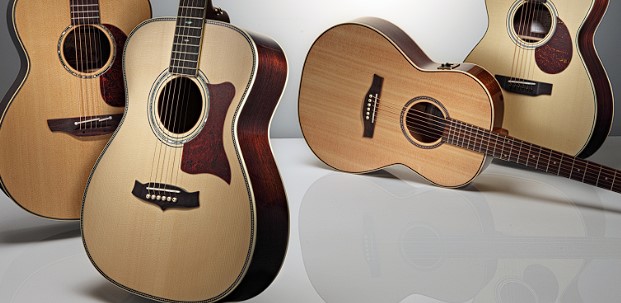
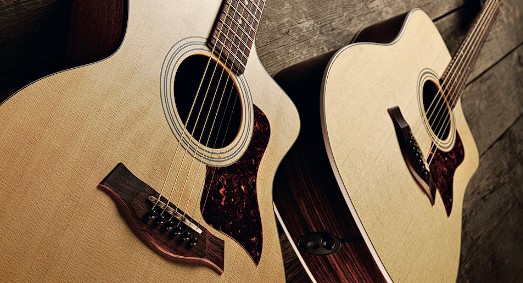

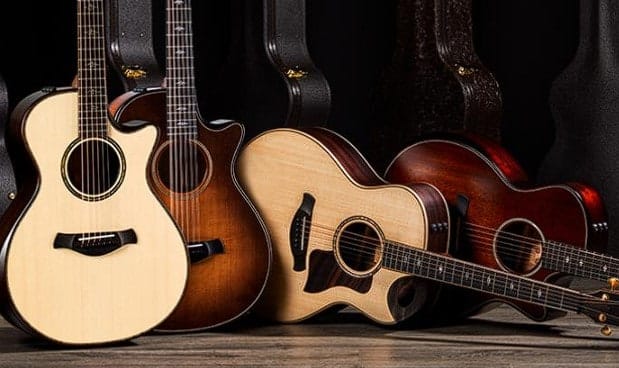
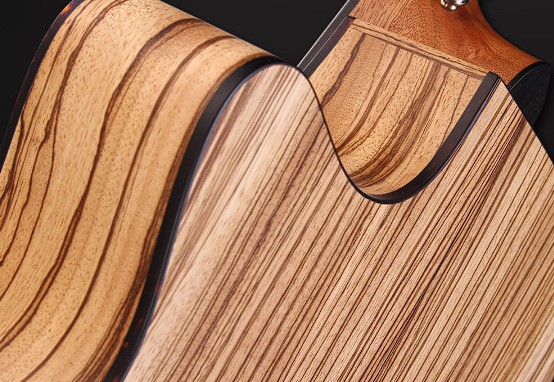

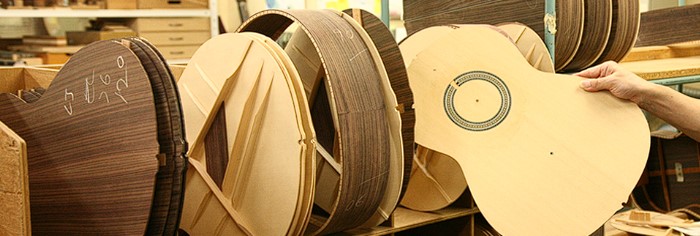

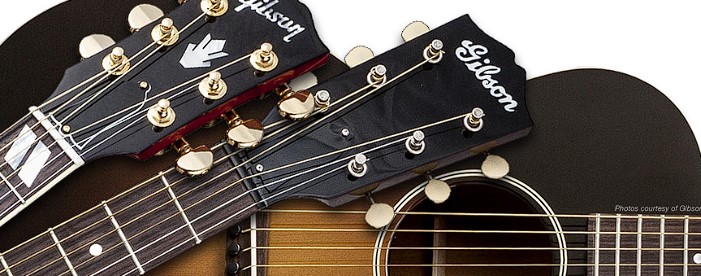
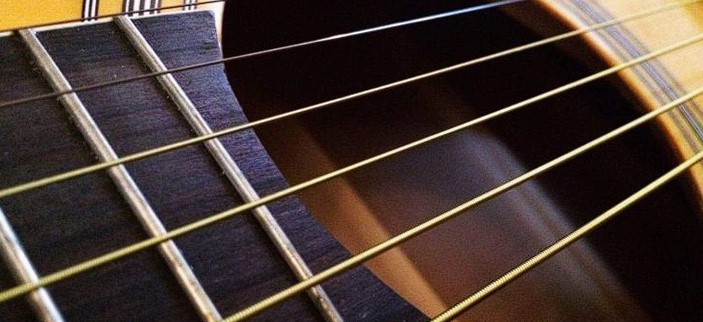







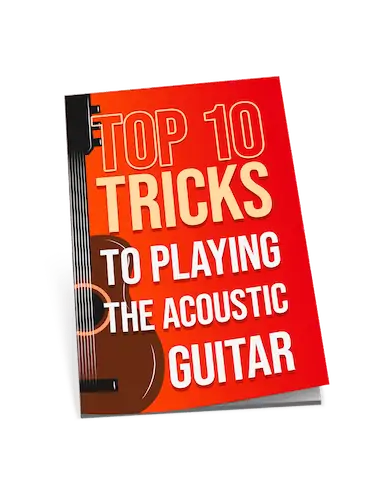

While the article extensively covers various aspects of choosing an acoustic guitar, I find there’s a lack of emphasis on the influence of vintage models on the instrument’s sound character. Vintage guitars often have a unique tone that new ones might not replicate. It’s an interesting topic for collectors and enthusiasts.
Regarding acoustic guitar electronics, an overlooked aspect is the ability to easily experiment with different soundscapes. The option to plug in doesn’t just amplify sound; it opens up a landscape of effects and enhancements.
Who knew that picking an acoustic guitar could be more complex than my last relationship? Between body woods, string types, and whether to go electric or not, it’s like swiping through an endless dating app of guitars. Hoping my ‘match’ comes with a user manual and less commitment issues!
Oh, if only guitars came with a compatibility quiz before purchase, we’d all make the perfect match on the first try!
Super helpful article, thanks! I’m on the lookout for my first guitar and leaning towards an acoustic. The section on guitar strings was particularly enlightening. Never knew how much of an impact they could have on the sound.
You’ve made some interesting points about acoustic versus electro-acoustic guitars, but I feel the need to clarify that electro-acoustics can indeed match the sound quality of their purely acoustic counterparts when unplugged. The primary difference lies in their ability to be amplified for larger venues without compromising on sound quality. It’s imperative for readers to understand that the choice largely depends on their performance needs and not solely on sound quality.
Oh great, another guitar buying guide. Because it’s not like we have a million of those already. Bet it doesn’t tell me which guitar is best for smashing onstage.
this article is a treasure trove for guitar lovers! especially found the part about the acoustic guitar body woods super helpful. it’s amazing how different woods can change the sound!
While I appreciate the rundown on different acoustic body woods, I think there’s too much emphasis placed on this aspect. In my experience, the player’s skill and the guitar’s overall setup play far more critical roles in the sound. Yes, wood type contributes to tonal characteristics, but let’s not overshadow other significant factors like the guitar’s construction and the player’s technique.
Loved the part about the types of acoustic guitars. I’ve been curious about archtop guitars ever since I got into jazz music. The design’s so classy and I hear they have a distinct sound perfect for jazz and blues. Can’t wait to save up for one and try it out.
so if i’m just starting, should i lean more towards a classical guitar cause of the nylon strings? heard they are easier on the fingers for newbies. not sure what’s best for learning the basics and not giving up cause of sore fingers lol.